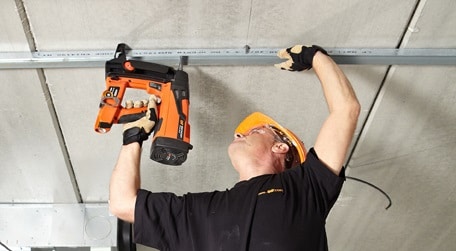Working in the finishes and interiors sector may be safer than working in agriculture or the oil and gas industry, but there are still certain risks that your employees will encounter.
Site managers and employers need to identify and mitigate potential risks to ensure that their employees remain fit and healthy, and that they are able to discharge their duties under the Construction Design and Management Regulations 2015 and The Health and Safety at Work Act.
Every site is different, but risk assessments need to be mindful of the following hazard
1: Asbestos
Still the UK’s number one cause of work-related deaths, asbestos presents a significant risk to employees. Used extensively in construction for decades, asbestos dust can be found in shops, offices and homes. When inhaled, asbestos particles lead to a range of respiratory illnesses including mesothelioma, a fatal form of lung cancer.
Site risk assessments must consider the potential presence of asbestos, the risk it presents and how it should be managed. Where significant risk is identified, the dust and cladding will need to be removed and disposed of properly to reduce the chances of lethal dust being inhaled.
2: Dust
During a refurbishment project, construction and fit-out typically creates a variety of dusts. Carpentry generates sawdust, stone masonry and dressing creates silica dust, and removal of redundant materials releases all manner of accumulated dust – all of which are easily inhaled, creating a number of potential problems.
From harmless, annoying irritation of the nose, throat and eyes, to the more serious accumulation of dust in the lungs, employees working with, and inhaling, sawdust are four times more likely to develop asthma. The dust created by cutting certain hardwoods can also cause cancer of the nose.
Silicosis is a condition caused by the inhalation of crystalline silica, generated when stone is cut. Not only does the dust collect in the lungs, but it also causes scarring to the tissue, the development of a chronic cough and, in some cases, lung cancer and death.
Employers are legally bound to monitor and control airborne dust, ensuring that levels do not exceed 5mg per cubic metre. For significant dust-generation projects, site owners need to install extraction equipment and issue employees with personal protective equipment (PPE) to limit dust inhalation.
3: Manual handling
Carrying or supporting heavy, awkward weights throughout the course of the day can cause injury, and where manual handling best practice is not applied, the potential for injury increases exponentially.
Employers need to ensure that fitters are properly trained to assess weights before lifting, and that they are using safe lifting and carrying techniques. Where problems are identified, fitters need to be supplied with lifting equipment to help them maintain safety standards.
4: Noise
The sound levels created by tools can cause permanent hearing damage. Every year up to 20,000 people report work-related hearing problems, and between 150 and 200 workers go deaf because of industrial noise.
Employers are expected to monitor and reduce workplace noise to keep it within a specified range to protect their workers. Any measures taken must first focus on reducing noise in general to minimise risks to everyone in the area. Where employees are engaged directly with noisy equipment in excess of 85db, they need to be issued with ear defenders or other suitable PPE.
You have a noise problem if your employees have to raise their voices to carry out a normal conversation when about 2 metres apart for at least part of the day.
5: Personal protective equipment
Where fitters are exposed to hazardous substances, noise or other environmental factors that pose a health risk, employers need to issue suitable PPE. The routine risk assessments undertaken for every fitting-out activity should identify tasks requiring PPE, along with suggestions about the exact equipment required.
Goggles, face masks, gloves and ear defenders should all be standard equipment, but employees also require training to ensure they know when and how to use them for maximum protection.
6: Working at height
Building partitions, plastering walls and installing suspended ceilings are often carried out above head height. Whenever a ladder or scaffolding tower is being used, employers need to ensure that an adequate risk assessment has been performed, and that employees have been properly trained in working safely at height.
As much of the day-to-day assessment and mitigation will need to be performed by fitters themselves, full training is essential.
7: Personal health
No matter how rigorous the risk assessment and mitigation process, employees working on-site retain a certain degree of personal responsibility for ensuring that method statements are followed correctly. If your business employs CSCS-certified workers, you can be sure that they will already have a working knowledge of personal health and safety when they arrive on-site.
However, you must also train employees on using specific equipment or techniques safely, empowering them to mitigate and avoid health risks themselves. Regular refresher training and assessments will help to spot where corners are being cut, or bad working practices are circumventing risk assessments and protective measures.
8: Site welfare
Prior to starting a project, you must ensure sufficient welfare provisions are in place on-site. Employees need access to toilets, washing facilities and adequate drinking water. For extended projects, they also need changing facilities and somewhere secure to store PPE when not in use. These provisions must form part of your early project planning and risk assessment.
This all sounds very complicated, but in most cases, keeping employees safe on-site is a case of applying common sense to every situation. But if you are in any doubt, you must obtain professional assistance or you potentially risk the health and safety of employees.
So, over to you. As an employer, it is your responsibility to keep employees working on finishing and interiors projects safe.


